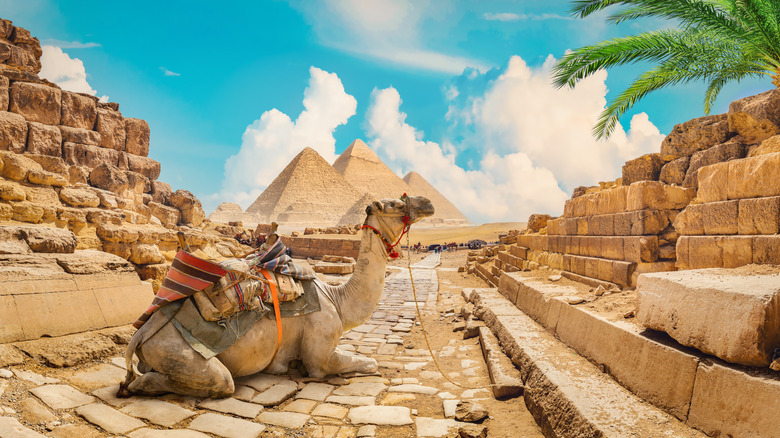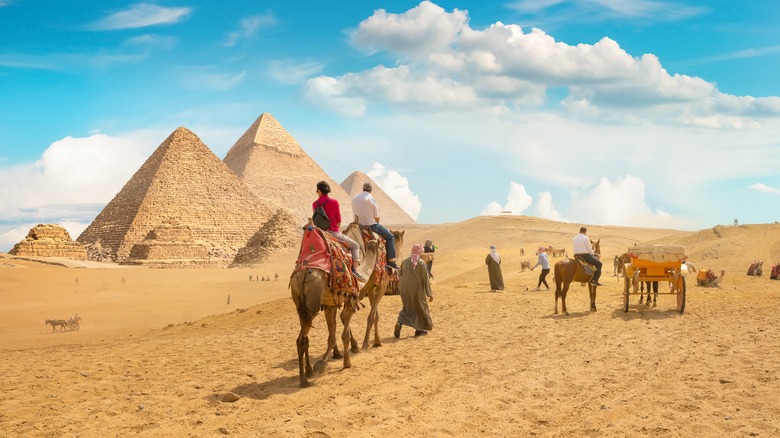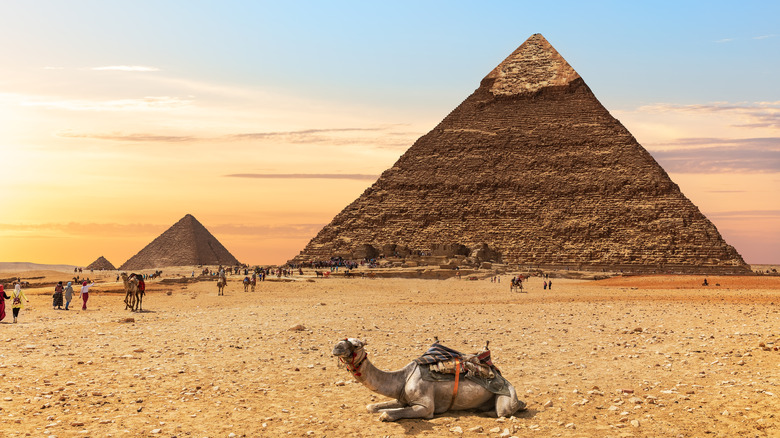Why You Should Add A Camel Ride At The Pyramids Of Giza To Your Bucket List
The Pyramids of Giza: Mysterious, mystical, and downright ancient. Estimated to have been built between 2550 to 2490 B.C. (per National Geographic), the three pyramids known as Khufu (aka, the Great Pyramid of Giza), Khafre, and Menkaure, have fascinated archaeologists, historians, residents, and visitors for centuries, and still do in present day. Their pivotal and grandiose positions within the UNESCO World Heritage Site known as the Giza Necropolis/Old Kingdom of Egypt — guarded by the equally mysterious Great Sphinx of Giza — make them visible from both Cairo and outer space.
Standing prominently upon the edge of the Sahara Desert, the Pyramids of Giza beckon to be admired. And, there are a host of options for making your way to the pyramids but be prepared to pay an admission fee to gain entry to the Giza Plateau in order to see them: Egypt's ancient world now intermingles with a modern-day, theme park-style entrance to gain access. Reaching the entrance to the pyramids (you can indeed explore inside) by various modes of transport is recommended. Once inside however, you have the option of either walking endlessly uphill toward, and around these ancient, pyramidal tombs and chambers, or do what the Egyptians do: Take a camel ride.
Walk like an Egyptian: No, take a camel instead
It has to be nearly everyone's dream destination to see the Pyramids of Giza at least once in their lifetime. Add the factor of riding up towards their fascinating and mystical structures on the back of a camel, and that ticks all the boxes on your bucket list for your trip to Egypt. Truth be told, who wouldn't want to take a camel ride across the Sahara Desert towards the greatest, metaphysical, architectural giants of the ancient world?
Riding on the back of a camel at sunset is a must-do while visiting the pyramids. However, doing so could put you at great risk if not done properly. You see, entry into and out of the Giza Plateau takes place after sunrise and long before sunset, according to the Pyramids of Giza's opening hours. To attempt visiting the area on your own before or after the scheduled viewing hours would be illegal. In order to take advantage of this spectacular experience of the sun setting between and behind the pyramids, opting to go via a certified camel tour operator will help you legally bypass the restricted hours.
Everyday is Hump Day on the Giza Plateau
So, let's talk about these camels, shall we? According to the National Park Service, camels have been around since the Eocene era. While certain breeds have become extinct throughout the centuries, two are still in existence today and can be identified by the number of humps on their backs. When deciding how to go about riding a camel at the Pyramids of Giza, it's important to note that there are correct and incorrect ways of hiring one.
As mentioned previously, finding a certified camel tour operator is essential, as there are numerous camel hustlers throughout the Giza Plateau that are unqualified trainers, quite insistent, and out to make a quick buck off tourists. It's also important to note that camels — as are all animals — are sentient beings. Which means they have feelings just like we do, and are quite perceptive. Finding an ethical camel tour operator will afford both you and the camels a calm, peaceful and memorable experience while riding across the Sahara Desert towards the Pyramids of Giza. And in doing so, not only are you truly partaking in an authentic mode of travel used for centuries in Egypt while visiting these ancient wonders, you'll be ensuring the camels are being respected as well. The Pyramids of Giza should be on every traveler's bucket list, and this is undoubtedly the best way to experience the magic.


